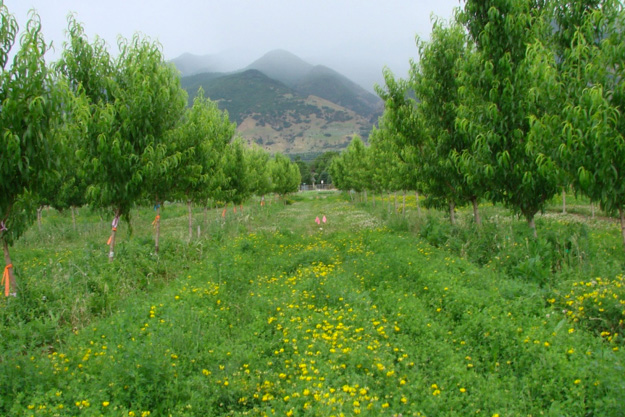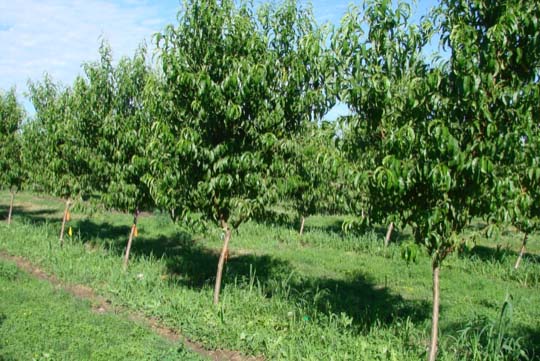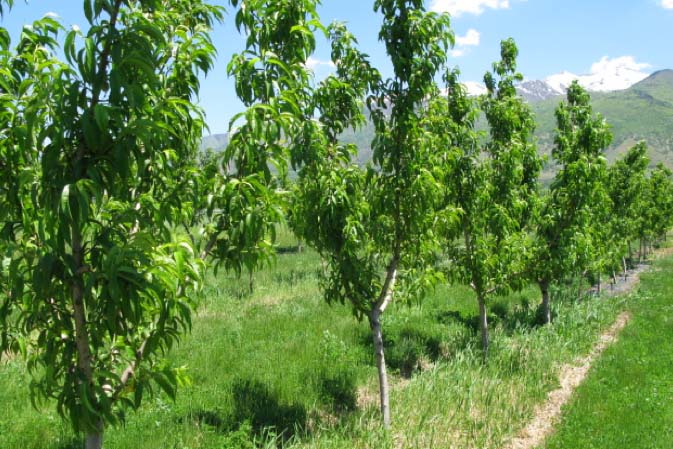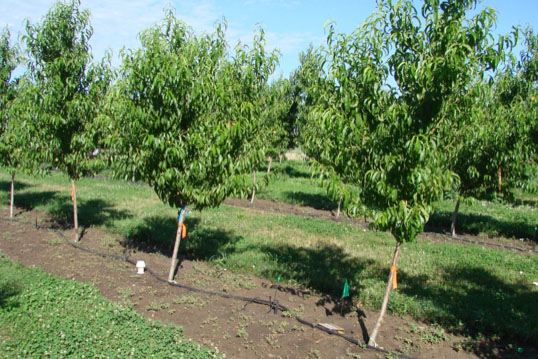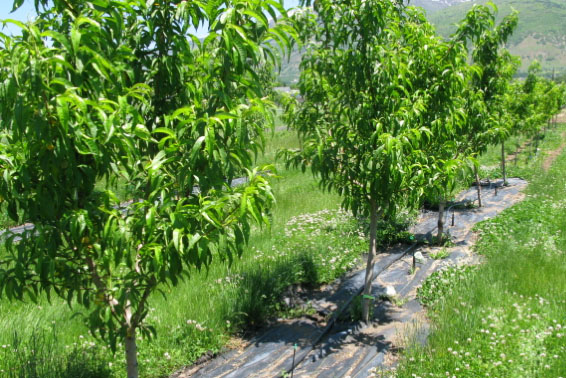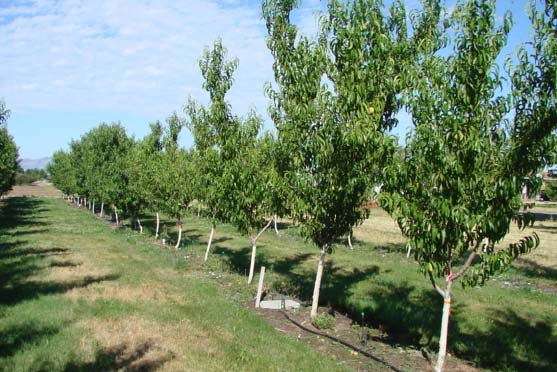Organic Stone-Fruit Production
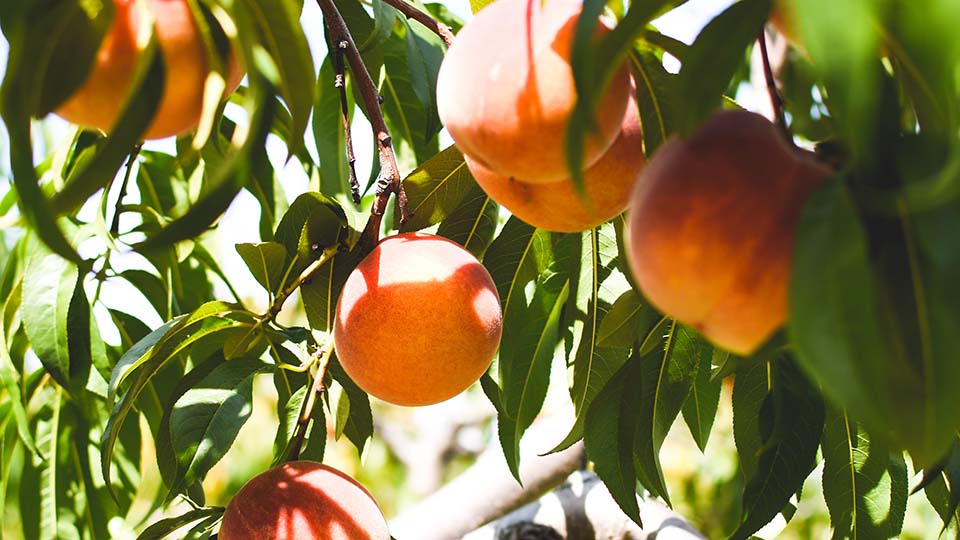
Situation
The Wasatch Front is a prime location for tree-fruit production in Utah.
Rapid urbanization, dwindling water resources, rising costs of inputs, and loss of export markets is making it increasingly difficult to continue farming in the area.
Organic and reduced-input production may help growers access growing local markets, benefiting a rural way of life and providing economic incentives for managed urban growth and farmland preservation.
Organic and reduced-input production may help reduce costs and benefit the environment through enhanced synergies between ecosystem services and production goals.
Objectives
- Characterize potential tradeoffs in water use efficiency and tree growth with living and non-living mulches and internal (N fixing legumes) and external fertility inputs.
- Characterize system responses to management practices through monitoring weeds, arthropod dynamics and soil quality.
- Select orchard floor cover crops for early season N release in environments with cold winters, arid summers and shallow alkaline soils.
- Select orchard floor management, fertility and pest management practices for: a. increased fruit quality b. maximum ecosystem services c. maximum economic return 5. Increase adoption of new management practices through education and outreach
Actions
Treatment
Organic Orchard: random complete block design with four replicates
| Treatment | In Row | Alleyway |
|---|---|---|
| 1 | straw mulch + compost | grass |
| 2 | straw mulch + compost | legume* |
| 3 | alyssum living mulch + compost | grass |
| 4 | alyssum living mulch + compost | legume |
| 5 | woven tabric + compost | grass |
| 6 | tillage + compost | legume |
Integrated Orchard: random complete block design with four replicates
| Treatment | In Row | Alleyway |
|---|---|---|
| 1 | conventional herbicide + NPK | grass |
| 2 | conventional transitioned to organic in 2011 | grass |
| 3 | conventional herbicide + compost | grass |
| 4 | paper mulch + reduced herbicide + NPK | grass |
| 5 | paper mulch + organic herbicide + compost | grass |
Organic Pest and Disease Control
We are monitoring pest and disease dynamics and the efficacy of organic pest control strategies. Information is available on Utah's pests and diseases.
Educational Activities
Field days to showcase the project were held at the Kaysville Horticultural Research Station in August 2008, 2010 and 2012. A field day and workshop dedicated to organic treefruit and vegetable production is planned for June 2013.
Future Goals
Create a long-term research site that can be used for cross-disciplinary whole systems research to develop integrated solutions, and demonstration of effective systems practices to the public. Potential Contributions:
- soil microbial ecology
- landscape ecology
- social sciences
- macro, meso and micro scale modeling.
Orchard Floor Management
We are investigating alternative orchard floor management strategies in order to reduce inputs for shallow alkaline soils, short hot summers, and cold winters.
Soil Fertility and Soil Quality
Baseline soil nutrients (0-30 cm) and soil quality (0-10 cm) measurements were taken from each plot. Soil and tissue N will be sampled monthly from April to September. Compost is applied to meet soil test phosphorus needs and fertilizer (NatureSafe 13-0-0) adjusted at the plot level to meet tree need.
Water use Efficiency
Each plot is equipped with micro sprinklers on individually controlled irrigation systems. This allows each of the treatments to be watered independently based on tree need, and allows water use for each treatment to be calculated separately.
Mulch and Organic Herbicide Selection
In 2008 and 2009 we assessed newsprint, straw and woodchips alone and in combination with acetic acid (20%), Matran (clove oil), Greenmatch EX (lemongrass oil), a citric acid based experimental product and glyphosate for weed control.
Potential Benefits
This project and its outreat and educational activities will help growers:
- learn about new orchard managemnet practices for utah
- learn about the importance of ecosystem services
- learn about the need for integrated solutions. The replicated field trials will improve understanding of how trees, living and non-living mulches and nutrient sources interact with or alter pest dynamics water use, soil quality, fruit quality and economics.
Acknowledgements: We acknowledge the usda organic research and extension initiative (OREI), Utah agricultural experiment station, the utah specialty crop block grant program and utah state university extension for funding this project.
Further results can be found at the Urban Small Farms Workshop and ISHS Symposium Talks.


